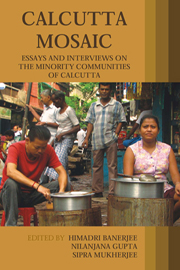Book contents
- Frontmatter
- Contents
- List of Contributors
- Acknowledgements
- Introduction
- 1 Mapping the Spaces of Minorities
- 2 The Armenians of Calcutta
- 3 The Jews of Calcutta: An Interview with Michael Ezra
- 4 The Sindhis of Calcutta
- 5 The City of Colleges
- 6 The Chinese Community of Calcutta
- 7 The Anglo–Indians of Calcutta
- 8 The Biharis of Calcutta
- 9 Agraharis of Calcutta
- 10 A Journey into My Neighbourhood
- 11 The ‘South Indians’ of Calcutta: Experiences in Cultural Processes
- 12 ‘Non-Bengali’ Icons of Malevolence
- 13 Selfing the City
6 - The Chinese Community of Calcutta
An Interview with Paul Chung
Published online by Cambridge University Press: 05 March 2012
- Frontmatter
- Contents
- List of Contributors
- Acknowledgements
- Introduction
- 1 Mapping the Spaces of Minorities
- 2 The Armenians of Calcutta
- 3 The Jews of Calcutta: An Interview with Michael Ezra
- 4 The Sindhis of Calcutta
- 5 The City of Colleges
- 6 The Chinese Community of Calcutta
- 7 The Anglo–Indians of Calcutta
- 8 The Biharis of Calcutta
- 9 Agraharis of Calcutta
- 10 A Journey into My Neighbourhood
- 11 The ‘South Indians’ of Calcutta: Experiences in Cultural Processes
- 12 ‘Non-Bengali’ Icons of Malevolence
- 13 Selfing the City
Summary
The first Chinese immigrant to Calcutta was Yang Tai Chow. He arrived in 1778 on the banks of the Hooghly. He gathered together a group of Chinese, many of whom had jumped ship and decided to stay on in the area of Calcutta or were working on the Khidderpore docks. Yang started a sugar mill with the eventual goal of saving enough to start a tea trade. Though history has obliterated the sugar mill, Yang's endeavour has been immortalized in the Bengali word for sugar, chini, which is derived from the Mandarin (similar to the Bengali word for porcelain, chinamati). Yang, known locally as Tong Achi, established the first Chinese community in the area which came to be known as Achipur, a place 33 km from Calcutta, near Budge Budge. The place no longer has any Chinese inhabitants but Yang Tai Chow's grave, and a temple that he built, are still visited by the Calcutta Chinese at the time of the Chinese New Year to seek his blessings.
Geographical proximity of the city to China and its accessibility by land made Calcutta the natural choice for many emigrating Chinese. The first record of modern Chinese immigration to India, writes Haraprasad Roy, can be found in a short notice in the Chinese book of 1820, A Maritime Record. It mentions the city of Calcutta as housing a small Chinese population from Fujian (Fukien) and Guangdong (Canton).
- Type
- Chapter
- Information
- Calcutta MosaicEssays and Interviews on the Minority Communities of Calcutta, pp. 131 - 142Publisher: Anthem PressPrint publication year: 2009
- 1
- Cited by



